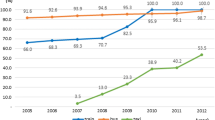Abstract
Electronic fare payment systems have gained much popularity in large public transport systems across the world. Though their main purpose is to collect the revenue and improve passenger’s comfort, they also generate huge amount of detailed and accurate data on onboard transactions which is of extreme importance for transit planners for efficient short-term and long-term transit operation and service planning. This paper attempts to utilize the smart card data as an input for large-scale activity based public transport simulation for analyzing travel behavior pertaining to transit users, using an open source agent-based transport simulation package, MATSim. Transit vehicles are optimized based on input demand generated by smart card and a high temporal resolution of waiting time and its components at different stations is extracted which is very important in managing the frequency and headway of transit vehicles. Since no card swipe is needed for transfers within subway system in Seoul, the data is not readily available to detect frequent transfer locations. However, after validating the boarding and alighting volumes at different stations, a methodology is presented to calculate within subway transfer volumes at different stations. We suggest that by improving the statistical analysis and utilizing advanced data mining techniques, smart cards can effectively generate the microsimulation travel demand models.
Similar content being viewed by others
References
Agard, B., Morency, C., and Trepanier, M. (2007). Mining public transport user behaviour from smart card data, CIRRELT-2007-42. Centre interuniversitaire de recherche sur les reseaux d’entreprise, la logistique et le transport (CIRRELT), Canada.
Arana, P., Cabezudo, M., and Penalba, M. (2014). “Influence of weather conditions on transit ridership: A statistical study using data from smartcards.” Transportation Reasearch Part A, Vol. 59, pp. 1–12, DOI: 10.1016/j.tra.2013.10.019.
Bagchi, M. and White, P. R. (2005). “The potential of public transport smart card data.” Transport Policy, Vol. 12, No. 5, pp. 464–474, DOI: 10.1016/j.tranpol.2005.06.008.
Barry, J. J., Newhouser, R., Rahbee, A., and Sayeda, S. (2002). “Origin and destination estimation in New York City with automated fare system data.” Transportation Research Record: Journal of the Transportation Research Board, No. 1817, Transportation Research Board of the National Academies, Washington, D. C, pp. 183–187, DOI: 10.3141/1817-24.
Farzin, J. M. (2008). “Constructing an automated bus origin-destination matrix using farecard and global positioning system data in Sao Paulo, Brazil.” Transportation Research Record: Journal of the Transportation Research Board, No. 2072, Transportation Research Board of the National Academies, Washington, D.C., pp. 30–37, DOI: 10.3141/2072-04.
Horni, A., Scott, D. M., Balmer, M., and Axhausen, K. W. (2009). “Location choice modeling for shopping and leisure activities with MATSim: Combining microsimulation and time geography.” Transportation Research Record: Journal of the Transportation Research Board, No. 2135, Transportation Research Board of the National Academies, Washington, D.C., pp. 87–95, DOI: 10.3141/2135-11.
Jang, W. (2010). “Travel time and transfer analysis using transit smart card data.” Transportation Research Record: Journal of the Transportation Research Board, No. 2144, Transportation Research Board of the National Academies, Washington, D. C, pp. 142–149, DOI: 10.3141/2144-16.
Kim, J. Y., Yu, Y. S., and Lee, S. J. (2013). “A study on the evacuation route of areas prone to floods using disaggregare behavioral model.” Journal of KOSHAM, Vol. 13, No. 3, pp. 61–67, DOI: 10.9798/ KOSHAM.2013.13.3.061.
Kim, J. Y., Yu, Y. S., Lee, S. J., Hu, H. J., and Sung, J. G. (2012). “Application of multi-agent transport simulation for urban road network operation in incident case.” International Journal of Highway Engineering, Vol. 14. No. 4, pp. 1–8, DOI: 10.7855/IJHE. 2012.14.4.163.
Li, Z. C., Lam, W. H. K., and Wong, S. C. (2009). “The optimal transit fare structure under different market regimes with uncertainty in the network.” Networks and Spatial Economics, Vol. 9, No. 2, pp. 191–216, DOI: 10.1007/s11067-007-9058-z.
Ma, X., Wu, Y. J., Wang, Y., Chen, F., and Liu, J. (2013). “Mining smart card data for transit riders’ travel patterns.” Transportation Research Part C: Emerging Technologies, Vol. 36, pp. 1–12, DOI: 10.1016/ j.trc.2013.07.010.
MATSim-T. (2014). Multi agent transportation simulation toolkit (http://www.matsim.org, accessed July 2014).
Morency, C., Trepanier, M., and Agard, B. (2007). “Measuring transit performance using smart card data.” Presented at World Conference on Transport Research, San Francisco, USA.
Munizaga, M. A. and Palma, C. (2012). “Estimation of a disaggregate multimodal public transport origin-destination matrix from passive smartcard data from santiago, Chile.” Transportation Research Part C, Vol. 24, pp. 9–18, DOI: 10.1016/j.trc.2012.01.007.
Ortuzar, J. de D., and Willumsen, L.G. (2011). Modelling transport, 4th Edition. John Wiley & Sons, Inc.
Park, J. Y., Kim, D. J., and Lim, Y. T. (2008). “Use of smart card to define public transit use in Seoul, South Korea.” In Transportation Research Record: Journal of the Transportation Research Board, No. 2063, Transportation Research Board of the National Academies, Washington, D.C., pp. 3–9, DOI: 10.3141/2063-01.
Rieser, M. (2010). Adding transit to an agent-based transportation simulation: Concepts and implementation, PhD Thesis, V SP, TU Berlin, Germany.
Sun, L., Lee, D. H., Erath, A., and Huang, X. (2012). “Using smart card data to extract passenger’s spatio-temporal density and train’s trajectory of MRT system.” Proceedings of the ACM SIGKDD International Workshop on Urban Computing, pp. 142–148.
Trepanier, M., Agard, B., Morency, C., Descoimps, E., and Marcotte, J. S. (2012). “Using smart card data to assess the impacts of weather on public transport user behavior.” Presented at Conference on Advanced Systems for Public Transit-CASPT12, Santiago, Chile, July 23-27, 2012.
Trepanier, M., Habib, K. H. N., and Morency, C. (2012). “Are transit users loyal? revelations from a hazard model based on smart card data.” Canadian Journal of Civil Engineering, Vol. 39, No. 6, pp. 610–618, DOI: 10.1139/l2012-048.
Zhao, J., Rahbee, A., and Wilson, N. H. M. (2007). “Estimating a rail passenger trip origin-destination matrix using automatic data collection systems.” Computer-Aided Civil and Infrastructure Engineering, Vol. 22, pp. 376–387, DOI: 10.1111/j.1467-8667.2007.00494.x.
Author information
Authors and Affiliations
Corresponding author
Rights and permissions
About this article
Cite this article
Ali, A., Kim, J. & Lee, S. Travel behavior analysis using smart card data. KSCE J Civ Eng 20, 1532–1539 (2016). https://doi.org/10.1007/s12205-015-1694-0
Received:
Accepted:
Published:
Issue Date:
DOI: https://doi.org/10.1007/s12205-015-1694-0




